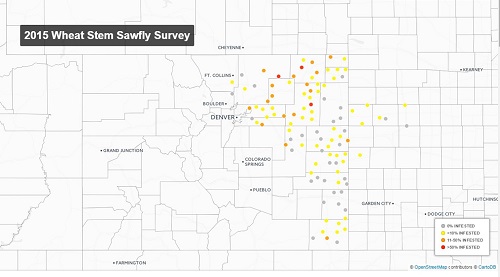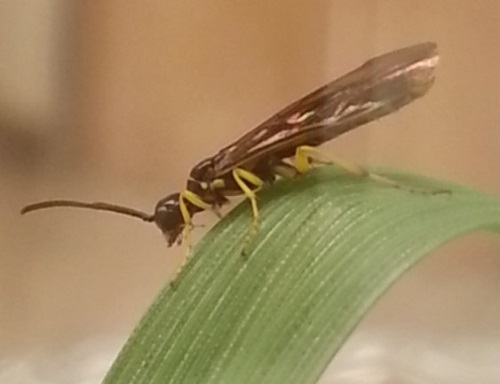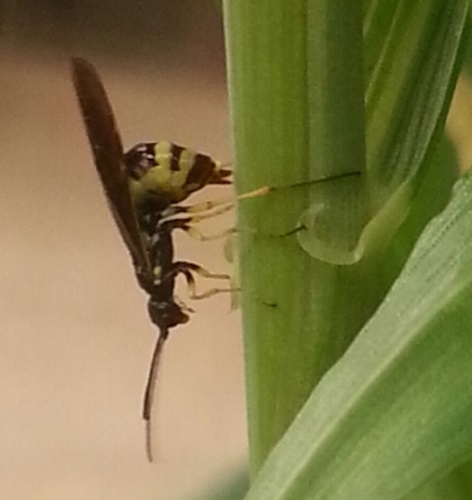Wheat Stem Sawfly
Helpful Resource:
http://www.bookstore.ksre.ksu.edu/pubs/mf3089.pdf
The wheat stem sawfly is an insect that girdles the stem of wheat plants and causes the plant to lodge just prior to harvest. It seems to be slowing moving toward northwest Kansas, so we need to be on the lookout for the adult and it’s damage in our wheat.
This insect is a problem north and west of us, in northeastern Colorado, the Nebraska panhandle, Wyoming, Montana and even into Canada. Surveys to locate the insect have been occurring for several years and are coordinated by Colorado State University. Last year, adult wasps were found in very low levels in Cheyenne, Rawlins, Decatur, Sherman and Wallace Counties (Figure 1). This year, I will be participating in the Kansas portion of the survey to help gain a better understanding of the distribution of the insect in northwest KS.

Figure 1. 2015 distribution of the wheat stem sawfly, from survey conducted by Colorado State University.
The wheat stem sawfly is a small wasp, about half of an inch long. It has a black body with three broad transverse yellow bands on the on the abdomen. It’s wings are a dark translucent color.


Their damage can be difficult to assess until right before harvest. At that time, the wheat lodges. It looks like a different type of lodging than we typically think of because the straw is cleanly severed, usually right above ground level. Then looking closely, you will see the stems packed with a frass, that resembles sawdust. This sawdust plug protects the larvae until emergence.
The challenge with this insect is that insecticides are not an effective control of the insect. This is because the adults emerge from the wheat residue over a long period of time – up to 5 weeks. In addition, the sawfly adults only live about a week. The sawflies mate as soon as the females emerge from the residue and then deposit eggs in neighboring wheat fields. This creates a situation that you would need multiple sprays to get effective control of the insect.
The other challenges with this insect are the harvest challenges and lack of residue that will remain in the field. Once the residue is detached, it easily blows away. You could end up with very little residue to plant into for next year’s corn as a result of the wheat stem sawfly.
We have been conducting research for 3 years of K-State research in northwest Kansas on solid stemmed wheat. The solid stemmed wheat is not completely ‘solid’ as the name would suggest, but has a thicker sidewall than the traditional hollow stemmed wheat that we are familiar with. This thicker sidewall prevents the female sawfly from penetrating the stem of the wheat plant. This prevents her from depositing the eggs in the stem, and therefore prevents reproduction.
The solid stemmed wheats that we are testing are primarily from Montana State University. Therefore, we are concerned about their ability to tolerate drought conditions. The last three years of research has not tested their drought tolerance because we have had such good growing conditions during the spring for wheat. In our research, we are showing the solid stemmed wheats yielding within 86% of the traditional hollow stemmed wheat. We have been quite surprised by this and are still a bit uncomfortable with how these wheats will do under hot and dry spring growing conditions.
The take home message is that we need your help on assessing the presence of wheat stem sawfly in northwest Kansas. If you notice lodging that you can’t explain at harvest this year, please let me know.